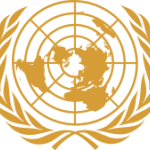- 行业: NGO
- Number of terms: 31364
- Number of blossaries: 0
- Company Profile:
The United Nations Organization (UNO), or simply United Nations (UN), is an international organization whose stated aims are facilitating cooperation in international law, international security, economic development, social progress, human rights, and the achieving of world peace.
1. Removal of salt from ocean or brackish water. It is achieved by various methods, for example, distillation, electrodialysis, ion exchange, multiple-effect distillation, reverse osmosis hyperfiltration, solar evaporation and vapour compression. 2. Removal of salt from soil by artificial means, usually leaching. It is also known as desalination.
Industry:Environment
Any (liquefied) gas that is used as the driving force in the expulsion of a liquid such as an aerosol spray from a container. Examples are nitrous oxide, carbon dioxide and halogenated hydrocarbons. The halogenated propellants such as chloro-fluorocarbons pose a threat to the earth's ozone layer and their use has been banned in many countries.
Industry:Environment
Measure of the volume of fish caught with a given number and type of vessels and fishing gear, and with a given number of fishermen. CPUE may vary with the amount of fish in the water (size of fish stocks), the congestion of vessels and other factors. It is an important indicator for estimating the size of fish stocks and the unit cost of fish catch.
Industry:Environment
Removal of water from any source, either permanently or temporarily. Mine water and drainage water are included. Water abstractions from groundwater resources are defined as the difference between the total amount of water withdrawn from aquifers and the total amount charged artificially or injected into aquifers. See also net abstraction of water.
Industry:Environment
Process in which precious metals such as platinum and palladium are used as catalytic agents for disposal of gaseous wastes (volatile organic compounds) that contain low concentrations of combustible material and air. The fact that catalytic incinerators require lower temperature than conventional thermal incinerators results in fuel and cost savings.
Industry:Environment
Formerly, United Nations Statistical Office, the body responsible for the collection, compilation and dissemination of international statistical data, the improvement of statistical methodology, substantive support for technical cooperation in statistics and the promotion of coordination in international statistical work.
Industry:Environment
Group of fish in a stock which were generated during the same spawning season and are born at the same time. In cold and temperate areas, where fish are long-lived, a cohort corresponds usually to a year class. In the tropics, where fish tend to be short-lived, cohorts may refer to shorter time intervals (e.g. spring cohort, autumn cohort, monthly cohorts).
Industry:Environment
1. Thermodynamic property of matter related to the amount of energy that can be transferred from one system to others in the form of work. 2. Quantitative measure of a physical system's natural tendency towards increased disorder. It has also been proposed as an environmental indicator of the ultimate limits to economic growth (Georgescu-Roegen, 1971).
Industry:Environment
Action taken to deal with the release of a hazardous substance that could affect humans and/or the environment. The term clean-up is sometimes used interchangeably with the terms remedial action, response action or corrective action as opposed to the terms preventive action or anticipatory action. See also environmental restoration or environmental protection.
Industry:Environment
Statistical system, developed by Statistics Canada, distinguishing among measures that exert stress on the environment (stress and stressor statistics), measures of the effects on the environment (environmental response) and measures of policy response (collective and individual responses). See also Framework for the Development of Environment Statistics (FDES).
Industry:Environment
